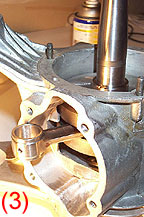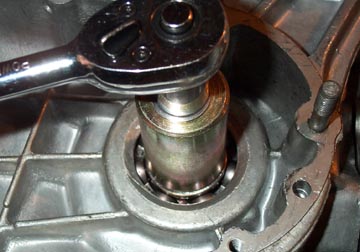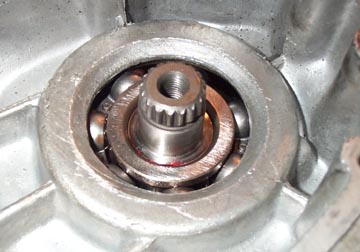 |
 |
 |
 |
 |
 |
 |
||||||||||||
Lambretta Engine WorkGeneralLambretta |
Installing a Lambretta crankThe Lambretta crank is a pretty cool design. It just clears the casing when installed and has to go in at a funny angle just to fit properly. The crank below is from a GP200 and it was fitted just as a test so it does not have the mag side flywheel race installed on the crank. Freezing the crank before installation is a neat trick that makes installation much easier. Just throw it in the freezer for a few hours before you install. The reason is that metal shrinks just slightly when cold and so the close tolerances of the bearing and the crank shoulder have more play. It is also useful to have a crank installation tool to pull the crank shoulder through the drive bearing. Above are
three shots of how the crank is installed. Click on each image to get a
larger view of each step. The first step is to grease the single drive side oil seal and bearing so that
the seal is not damaged during installation. If the motor is out of the
bike, set it so that the mag side flange opening is facing up.
(1) Turn the crank to bottom dead center so that the crank pin is furthest from the crank mouth. (2) Bring the crank down at an angle so the small end of the con rod fits through the left side main crankcase transfer. (3) Align the drive side of
the crank with the bearing hole and give it a good push. Do not use a
hammer to get the crank further into the bearing. Since there is a pin
at only one side of the crank, if you try and use a hammer you'll end
up possibly bending the crank and having to replace it later.
The crank installation tool is then
placed on the drive side of the bearing and a bolt is threaded into the
drive side shaft of the crank. Holding the crank with one hand, tighten
the bolt and the crank will slowly be pulled through until the shoulder
hits the bearing. This tool is cheap and available from MB Developments.
The crank shoulder never seems to come all the way flush with the side of the bearing but a quick look inside the engine shows that the crank web is almost touching the oil seal flange. I'll update this page if I have any problems with this installation. Next Section --> |
|||||||||||||||||




